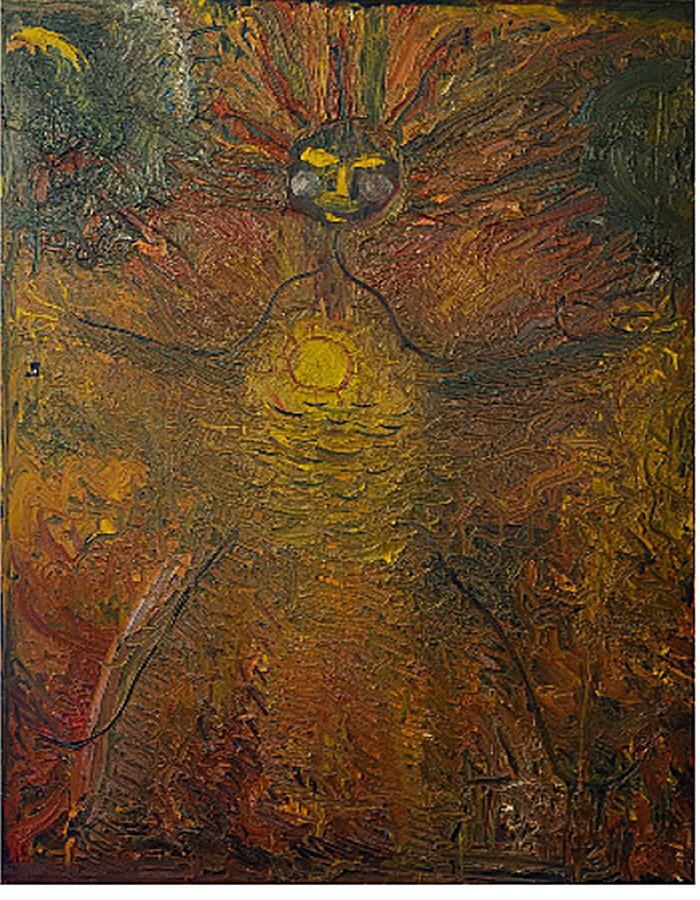Conny Waters – MessageToEagle.com – Numerous cultures around the globe are engaged in preserving their artistic legacies. This effort involves safeguarding these cultural treasures from being forgotten and emphasizing their significance to ensure they remain a vital part of their shared heritage.
Spirit of the Night by Khakas artist Alexander Domozhakov, oil on canvas, 1.6 × 1.1m, 1991 (collection of Olga Akhrimchik). Photograph by Andrzej Rozwadowski; source – Antiquity.
A new, valuable project is underway to assess the influence of ancient rock art on contemporary Indigenous art in Central Asia and Canada.
This study aims to explore how historical artistic expressions continue to shape and inspire modern Indigenous artists in these regions. The main goal of the study is to help Indigenous communities reclaim and strengthen their cultural identities.
In this case, the crucial role plays rock art that reflects people’s collective identities and ancestral connections to the lands they inhabit. However, the influence of rock art on current artistic movements still needs to be recognized and better understood.
The Bronze Age stela of the Okunevo culture (Khakas National Museum of Local Lore). Photograph by Andrzej Rozwadowski; source – Antiquity.
“The contemporary re-use of rock art is a growing phenomenon,” says author of the research. However, to date, very little attention has been paid to how rock art inspires contemporary Indigenous artists, especially in such little known areas as Siberia or Central Asia,” said Professor Andrzej Rozwadowski from Adam Mickiewicz University, Poland.
In his project “Rock Art as a Source of Contemporary Cultural Identity,” Professor Rozwadowski focuses on exploring and understanding the cultural significance of rock art created by Indigenous artists in Central Asia, specifically in regions such as Siberia and Kazakhstan, as well as in Canada.
It is also important to investigate how the work of the artists in these regions, was inspired by rock art.
Akhmet Akhat in his atelier in Almaty, Kazakhstan. Credit: Andrzej Rozwadowski
In Siberia and Kazakhstan, Soviet suppression often stifled Indigenous culture. Today, rock art inspires Indigenous peoples in post-Soviet regions to reconnect with ancestors, aiding in reclaiming lost cultural identities.
In Canada, a similar process occurred as a result of European colonization. As younger generations forget First Nations traditions, the application of ancient rock art to contemporary artistic expression is essential for the preservation of heritage.
Many Indigenous Canadian artists also consciously link rock art traditions to modern colonial injustice, for example, the residential schools system, acting as decolonizing symbols intended to heal some wounds in Indigenous history. Moreover, the way rock art motifs are incorporated into modern art is strikingly similar across thousands of kilometers.
Alexei Ulturgashev presenting his work inspired by prehistoric Siberian art motifs at Abakan in 2018 (photograph by Andrzej Rozwadowski).
“It turned out that both Asian and Canadian artists see a lot of similarities in the art they create”, states Professor Rozwadowski.
“The most memorable thing for me was what Canadian artist from the Cree Nation, Jane Ash Poitras said when I met her in Edmonton. When I showed her the work of the Khakass artist Alexander Domozhakov, from southern Siberia, she said: ‘
Isn’t it Norval Morrisseau?!’ (Canada’s most prominent Indigenous artist).”
Left) Abdrashit Sydykhanov Planet Moon, mixed materials, 700 × 700mm, 1996 (collection of Zauresh Sydykhanova); right) the petroglyphs from the Tanbaly—the anthropomorph standing on the bull is about 400mm high (photographs by Zauresh Sydykhanova & Andrzej Rozwadowski).
This research shows that applying rock art motifs to contemporary art is a deliberate act by Indigenous artists, emphasizing the resilience and cultural continuity of various historically oppressed peoples.
“Rock art is a source of both aesthetic and identity inspiration for contemporary artists,” concludes Professor Rozwadowski. “It demonstrates how rock art is important to many Indigenous artists as a source for rediscovering their cultural identities, especially now in post-colonial times.”
Written by Conny Waters – MessageToEagle.com – AncientPages.com Staff Writer








